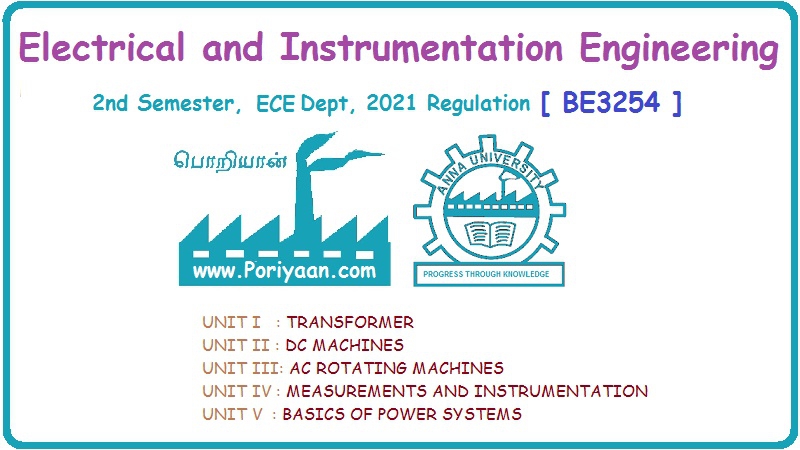Electrical and Instrumentation Engineering: Unit V: Basics of Power Systems
Various Voltage Levels
Electrical power Generation
In electrical generating power stations, electrical power is generated at medium voltage level that ranges from 11 kV to 25 kV.
VARIOUS VOLTAGE LEVELS
In
electrical generating power stations, electrical power is generated at medium
voltage level that ranges from 11 kV to 25 kV.
This
generated power is sent to the generating step up transformer to make the
voltage level higher. From this point to the user end voltage level varies in
different levels. We can realize this voltage level variation step by step.
i.
At 11 kV or more than that up to 25 kV voltage level is maintained at
alternator stator terminals to generate electrical power in the generating
station.
ii.
This generated power is fed to the generating step up transformer to make this
medium voltage level to higher level, i.e. up to 33 kV.
iii.
Power at 33 kV is sent to the generating substation. There the transformer
increases the voltage level to 66 kV or 132 kV.
iv.
From this generating substation power is sent to the nearer substation to
increase the voltage level higher than previous. This level of voltage is
increased at different suitable levels, it may be at 400 kV or 765 kV or 1000
kV. This high voltage or extra high voltage level is maintained to transmit the
power to a long distant substation. It is called primary transmission of power.
v.
At the end point of primary transmission of power, in the substation, the step
down transformers are used to step down the voltage level to 132 kV. Secondary
transmission of power starts from this substation.
vi.
Power transformer at the end of the secondary transmission, just makes 132 kV
voltage level steps down to 33 kV or 11 kV as per requirement. From this point,
the primary distribution of power starts to distribute power to different
distribution stations.
vii.
At the end of the primary distribution, the distribution stations receive this
power and step down this voltage level of 11 kV or 33 kV to 415 V (Line
Voltage). From these distribution stations to consumer ends, 415 V is kept to
sustain for utilization purpose.
Type of Power Lines

From
the very beginning of power generation to the user end transmission lines are
broadly classified based on different voltage levels.
As
electrical professionals, many of us have been coming across the terms LV or
LT, MV, HV or HT & EHV or EHT in our day-to-day professional lives. But are
we aware of the limits of these voltages as per Indian Standards and/or
International Standards?
This
article aims to analyze the limits set for these voltages in Indian as well as
International Standards.
Voltage
levels have been defined and classified by various National and International
Standards
The
following are the definitions given in various National & International
Standards for AC Voltages:
As
per the (erstwhile) Indian Electricity Rules, 1956, vide Rule 2(av), the
following were the limits:
i.
Low Voltage: - Not exceeding 250 V.
ii.
Medium Voltage: - Not exceeding 650 V.
iii.
High Voltage: - Not exceeding 33000 V.
iv.
Extra High Voltage: - Exceeding 33000 V
However,
it may be noted that the IE Rules have now been superseded by the Central
Electricity Authority (Measures Relating to Safety and Electric Supply)
Regulations, 2010 and the above definition is removed in the CEA Regulations,
2010.
As
such, as per the latest Regulations in vogue in India, there is no such
classifications as LV, MV, HV & EHV.
The National Electric Code (of
India) 2011 (Reaffirmed in 2016): Part 1 - Section 2
i.
Low Voltage: The voltage which does
not normally exceed 250 V (Cl. 3.3.37)
ii.
Medium Voltage: The voltage which
normally exceeds 250 V but does not exceed 650 V (Cl. 3.3.38)
iii.
High Voltage: The voltage which
normally exceeds 650 V (but less than 33 kV) (Cl. 3.3.39)
iv.
Extra High Voltage: The voltage
exceeding 33 kV under normal conditions (Cl. 3.3.40)
Note:
The definitions given in 3.3.37 to 3.3.40 are based on the provisions of IE
Rules. It may, however, be noted that voltage ranges as defined internationally
are at variance with the above definitions.
Grid
levels
The
entire Swiss electricity grid measures over 250,000 kilometres. If they were
placed end-to-end, its lines would reach around the Earth six times.
Extra-high-voltage
electricity (380,000 volts = 380 kV and 220,000 volts = 220 kV) reaches the
transmission grid from power plants as well as imports from abroad. The voltage
must be as high as possible so that as much energy as possible can be
transported over great distances with minimal losses.
By
the time the electricity finally reaches the power sockets in homes, the
voltage has to be reduced 1,000-fold (from 380,000 volts or 220,000 volts to
400 or 230 volts). This takes place across multiple stages and different grid
levels.
Level 1
The
380 kV or 220 kV electricity flows into the transmission grid from the power
plants and from abroad. This stage is referred to as the extra-high-voltage
level.
Level 3
The
voltage range between 36 kV and 150 kV is referred to as the high-voltage
level.
Level 5
The
voltage range between 1 kV and 36 kV is referred to as the medium-voltage
level.
Level 7
Any
voltage below 1 kV is referred to as the low-voltage level. This is the voltage
at which the electricity reaches the power sockets of households. Stages2, 4 and 6 are referred to as transformer levels. They transform the
electricity to the next level down (or up, if necessary).
Electrical and Instrumentation Engineering: Unit V: Basics of Power Systems : Tag: : Electrical power Generation - Various Voltage Levels
Related Topics
Related Subjects
Electrical and Instrumentation Engineering
BE3254 - 2nd Semester - ECE Dept - 2021 Regulation | 2nd Semester ECE Dept 2021 Regulation
